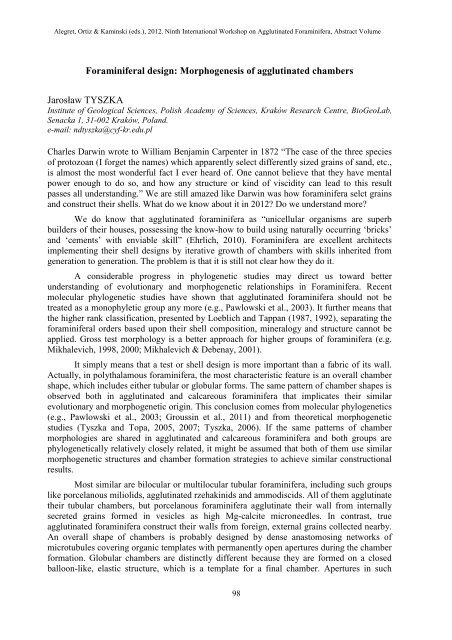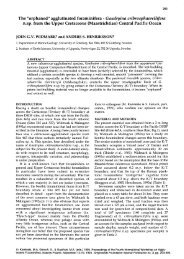Full Text | Download - Grzybowski Foundation - The ...
Full Text | Download - Grzybowski Foundation - The ...
Full Text | Download - Grzybowski Foundation - The ...
Create successful ePaper yourself
Turn your PDF publications into a flip-book with our unique Google optimized e-Paper software.
Alegret, Ortiz & Kaminski (eds.), 2012. Ninth International Workshop on Agglutinated Foraminifera, Abstract Volume<br />
Foraminiferal design: Morphogenesis of agglutinated chambers<br />
Jarosław TYSZKA<br />
Institute of Geological Sciences, Polish Academy of Sciences, Kraków Research Centre, BioGeoLab,<br />
Senacka 1, 31-002 Kraków, Poland.<br />
e-mail: ndtyszka@cyf-kr.edu.pl<br />
Charles Darwin wrote to William Benjamin Carpenter in 1872 “<strong>The</strong> case of the three species<br />
of protozoan (I forget the names) which apparently select differently sized grains of sand, etc.,<br />
is almost the most wonderful fact I ever heard of. One cannot believe that they have mental<br />
power enough to do so, and how any structure or kind of viscidity can lead to this result<br />
passes all understanding.” We are still amazed like Darwin was how foraminifera selct grains<br />
and construct their shells. What do we know about it in 2012? Do we understand more?<br />
We do know that agglutinated foraminifera as “unicellular organisms are superb<br />
builders of their houses, possessing the know-how to build using naturally occurring ‘bricks’<br />
and ‘cements’ with enviable skill” (Ehrlich, 2010). Foraminifera are excellent architects<br />
implementing their shell designs by iterative growth of chambers with skills inherited from<br />
generation to generation. <strong>The</strong> problem is that it is still not clear how they do it.<br />
A considerable progress in phylogenetic studies may direct us toward better<br />
understanding of evolutionary and morphogenetic relationships in Foraminifera. Recent<br />
molecular phylogenetic studies have shown that agglutinated foraminifera should not be<br />
treated as a monophyletic group any more (e.g., Pawlowski et al., 2003). It further means that<br />
the higher rank classification, presented by Loeblich and Tappan (1987, 1992), separating the<br />
foraminiferal orders based upon their shell composition, mineralogy and structure cannot be<br />
applied. Gross test morphology is a better approach for higher groups of foraminifera (e.g.<br />
Mikhalevich, 1998, 2000; Mikhalevich & Debenay, 2001).<br />
It simply means that a test or shell design is more important than a fabric of its wall.<br />
Actually, in polythalamous foraminifera, the most characteristic feature is an overall chamber<br />
shape, which includes either tubular or globular forms. <strong>The</strong> same pattern of chamber shapes is<br />
observed both in agglutinated and calcareous foraminifera that implicates their similar<br />
evolutionary and morphogenetic origin. This conclusion comes from molecular phylogenetics<br />
(e.g., Pawlowski et al., 2003; Groussin et al., 2011) and from theoretical morphogenetic<br />
studies (Tyszka and Topa, 2005, 2007; Tyszka, 2006). If the same patterns of chamber<br />
morphologies are shared in agglutinated and calcareous foraminifera and both groups are<br />
phylogenetically relatively closely related, it might be assumed that both of them use similar<br />
morphogenetic structures and chamber formation strategies to achieve similar constructional<br />
results.<br />
Most similar are bilocular or multilocular tubular foraminifera, including such groups<br />
like porcelanous miliolids, agglutinated rzehakinids and ammodiscids. All of them agglutinate<br />
their tubular chambers, but porcelanous foraminifera agglutinate their wall from internally<br />
secreted grains formed in vesicles as high Mg-calcite microneedles. In contrast, true<br />
agglutinated foraminifera construct their walls from foreign, external grains collected nearby.<br />
An overall shape of chambers is probably designed by dense anastomosing networks of<br />
microtubules covering organic templates with permanently open apertures during the chamber<br />
formation. Globular chambers are distinctly different because they are formed on a closed<br />
balloon-like, elastic structure, which is a template for a final chamber. Apertures in such<br />
98



